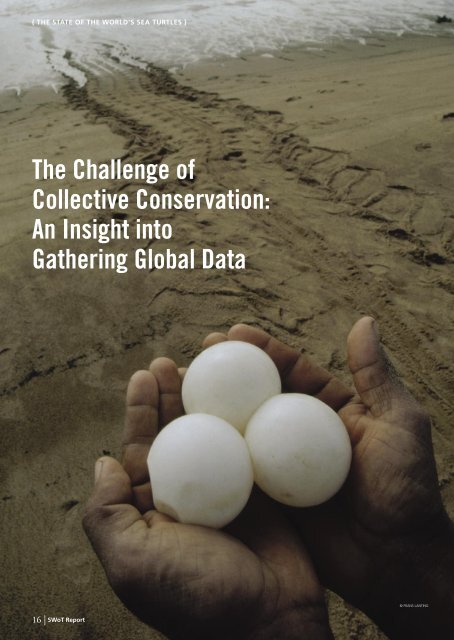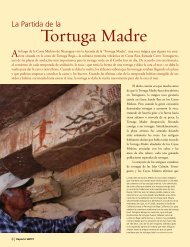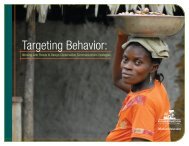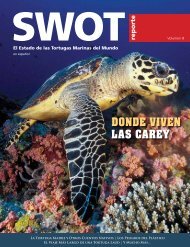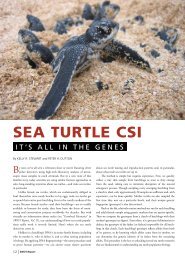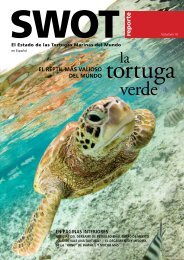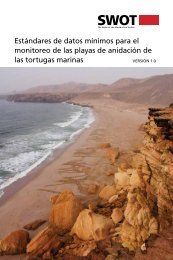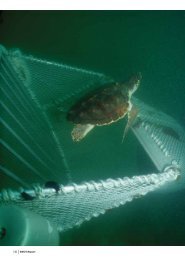The Challenge of Collective Conservation: An Insight into Gathering ...
The Challenge of Collective Conservation: An Insight into Gathering ...
The Challenge of Collective Conservation: An Insight into Gathering ...
You also want an ePaper? Increase the reach of your titles
YUMPU automatically turns print PDFs into web optimized ePapers that Google loves.
{ THE STATE OF THE WORLD’S SEA TURTLES }<br />
<strong>The</strong> <strong>Challenge</strong> <strong>of</strong><br />
<strong>Collective</strong> <strong>Conservation</strong>:<br />
<strong>An</strong> <strong>Insight</strong> <strong>into</strong><br />
<strong>Gathering</strong> Global Data<br />
© FRANS LANTING<br />
16 | SWoT Report
Sea turtles are global creatures, and the leatherback<br />
especially so, as its nesting distribution circles the<br />
globe (see map, pages 18–19). <strong>An</strong>d when they are not<br />
reproducing, leatherbacks swim thousands <strong>of</strong> miles and<br />
cross entire ocean basins. One <strong>of</strong> the greatest challenges<br />
we face in conserving leatherbacks is seeing the big<br />
picture and taking local actions that can have global<br />
significance in preventing extinction.<br />
<strong>The</strong> SWoT Team has committed to this challenge by bettering this<br />
big picture, our global view <strong>of</strong> leatherbacks. Our first step has been to<br />
compile information on leatherback nesting. Over the past two years,<br />
the SWoT Team has documented 203 leatherback nesting sites in 46<br />
countries. Nesting data from the last complete nesting season in 2004<br />
were contributed from 89 <strong>of</strong> these sites, and the remaining 114 either<br />
did not participate or do not have beach monitoring programs.<br />
Effectively creating this global picture has required carefully<br />
dealing with critical data deficiencies and incompatibilities. First,<br />
there are likely many leatherback nesting sites that have not been<br />
discovered, and even among the sites that we know exist, many have<br />
incomplete or no data on their turtles. Moreover, there is a good deal<br />
<strong>of</strong> incompatibility among data sets. With information from nearly 100<br />
sources and so many different areas <strong>of</strong> the world, we are faced with the<br />
tremendous challenge <strong>of</strong> creating uniformity among these diverse data<br />
sets. For example, some beach projects count the number <strong>of</strong> females,<br />
or the number <strong>of</strong> nests per season, while others count the number <strong>of</strong><br />
crawls per season. Perhaps even more complicated, data are collected<br />
under a wide range <strong>of</strong> monitoring efforts. Some projects monitor 100<br />
percent <strong>of</strong> the nesting beach during the nesting season or even all year,<br />
whereas other projects may have no regular beach monitoring; data<br />
might be collected only three mornings a week on only a portion <strong>of</strong><br />
the beach, or during a one-day aerial survey along the coastline <strong>of</strong> an<br />
entire country. <strong>The</strong> result is that one beach may appear to have more<br />
nesting turtles than another, when in reality this is due to differences<br />
in monitoring effort.<br />
Measures <strong>of</strong> monitoring effort are typically not well documented,<br />
and as such we are unable to evaluate the relative monitoring effort<br />
at each beach. Thus we cannot extrapolate full-season nesting values<br />
at beaches with partial coverage. <strong>The</strong>refore, caution must be exercised<br />
A leatherback nest is excavated after the hatchlings have emerged to assess the success<br />
rate <strong>of</strong> the nest. © MATTHEW GODFREY<br />
A leatherback nests by day. © JOHN CHEVALIER<br />
when comparing the relative nesting between sites displayed in the<br />
SWoT map.<br />
Although we have made every attempt to address these issues and<br />
present the most accurate picture possible, some notable assumptions<br />
were required in presenting these data. For the central map (pp. 18–19)<br />
we show the number <strong>of</strong> leatherback females nesting annually at all possible<br />
beaches. Because the number <strong>of</strong> nesting females is not available<br />
from every beach, for certain beaches we have estimated by dividing<br />
the recorded number <strong>of</strong> nests by a conversion value. It is important<br />
to note, therefore, that many <strong>of</strong> the points on the map are based on<br />
estimates and not actual numbers.<br />
We have separated nesting populations <strong>into</strong> two categories: those<br />
with their main foraging grounds in the Northern Hemisphere, and<br />
those with their main foraging grounds in the Southern Hemisphere.<br />
For each <strong>of</strong> these categories, we have selected a single clutch frequency<br />
value (average nests per female per year) to estimate the number <strong>of</strong> females<br />
nesting annually for rookeries within that category. <strong>The</strong>se average<br />
clutch frequencies are taken from the best-studied nesting rookeries in<br />
each group. For the Northern Hemisphere foragers, this rookery is at<br />
Sandy Point, St. Croix, U.S. Virgin Islands, and the average number <strong>of</strong><br />
nests laid per female in 2004 was 4.64—the observed clutch frequency<br />
(Alexander et al. 2004). For the Southern Hemisphere foragers, it is<br />
Playa Grande, Costa Rica, where the estimated clutch frequency in<br />
2003–2004 was 7.24 (Paladino & Spotila, pers. comm.).<br />
This map and database is an initial step in a long and evolving process.<br />
Recognizing the limitations and imperfections <strong>of</strong> this first step,<br />
we are committed to improving and refining this work over time. As<br />
we move <strong>into</strong> the future, the SWoT network will continue to grow, and<br />
we will update the SWoT database and find new ways to use these data<br />
for conservation action and to improve our understanding <strong>of</strong> the status<br />
<strong>of</strong> the world’s sea turtles.<br />
This article is written by Brian J. Hutchinson and María Fernanda<br />
Pérez, on behalf <strong>of</strong> the SWoT Team. Brian is Program Officer <strong>of</strong> the<br />
IUCN Marine Turtle Specialist Group and Coordinator <strong>of</strong> <strong>Conservation</strong><br />
International’s Sea Turtle Flagship Program. María is SWoT Data Coordinator.<br />
For a full list <strong>of</strong> SWoT Team members, see page 37.<br />
SeaTurtleStatus.org | 17


